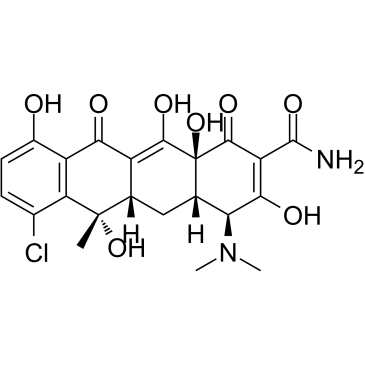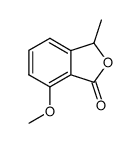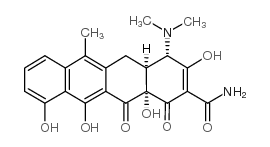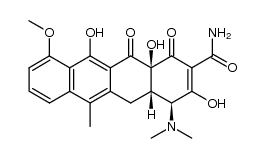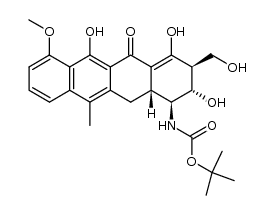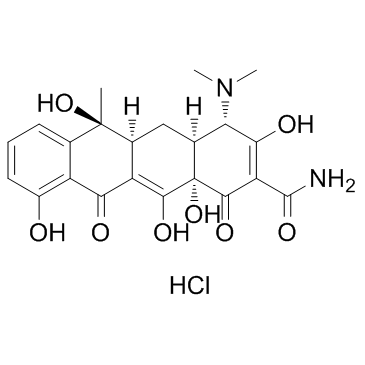60-54-8
| 中文名 | 四环素水合物 |
|---|---|
| 英文名 | tetracycline |
| 中文别名 | 四环素 |
| 英文别名 |
tetra-co
Abricycline Criseociclina Agromicina veracin cytome polyotic 2-naphthacenecarboximidic acid, 4-(dimethylamino)-1,4,4a,5,5a,6,11,12a-octahydro-3,6,10,12,12a-pentahydroxy-6-methyl-1,11-dioxo-, (4S,4aS,5aS,6S,12aS)- [4S-(4a,4aa,5aa,6b,12aa)]-4-(Dimethylamino)-1,4,4a,5,5a,6-11,12a-octahydro-3,6,10,12,12a-pentahydroxy-6-methyl-1,11-dioxo-2-naphthacenecarboxamide Tetrabon (4S,4aS,5aS,6S,12aS)-4-(Dimethylamino)-3,6,10,12,12a-pentahydroxy-6-methyl-1,11-dioxo-1,4,4a,5,5a,6,11,12a-octahydrotetracen-2-carboxamid (4S,4aS,5aS,6S,12aS)-4-(Dimethylamino)-3,6,10,12,12a-pentahydroxy-6-methyl-1,11-dioxo-1,4,4a,5,5a,6,11,12a-octahydrotetracene-2-carboxamide (4S,4aS,5aS,6S,12aS)-4-(Dimethylamino)-3,6,10,12,12a-pentahydroxy-6-methyl-1,11-dioxo-1,4,4a,5,5a,6,11,12a-octahydro-2-tetracenecarboxamide Bio-tetra (4S,4aS,5aS,6S,12aS)-4-(diméthylamino)-3,6,10,12,12a-pentahydroxy-6-méthyl-1,11-dioxo-1,4,4a,5,5a,6,11,12a-octahydrotétracène-2-carboxamide Sanclomycine Democracin Cyclomycin amycin Achromycin solvocin TETREX Polycycline (VAN) Tetradecin t-125 steclin Tetracycline tetracyclin panmycin Polycycline EINECS 200-481-9 Ambramycin Purocyclina 2-Naphthacenecarboxamide, 4-(dimethylamino)-1,4,4a,5,5a,6,11,12a-octahydro-3,6,10,12,12a-pentahydroxy-6-methyl-1,11-dioxo-, (4S,4aS,5aS,6S,12aS)- Omegamycin MFCD00150881 |
| 描述 | Tetracycline 是一种广谱抗生素,对多种革兰氏阳性和革兰氏阴性细菌有抑制活性。 |
|---|---|
| 相关类别 | |
| 靶点 |
Bacterial[1] |
| 参考文献 |
| 密度 | 1.3809 |
|---|---|
| 沸点 | 554.44°C |
| 熔点 | 175-177 °C(lit.) |
| 分子式 | C22H24N2O8 |
| 分子量 | 444.435 |
| 闪点 | 432.0±32.9 °C |
| 精确质量 | 444.153259 |
| PSA | 181.62000 |
| LogP | -1.47 |
| 外观性状 | 淡黄色晶体 |
| 蒸汽压 | 0.0±2.9 mmHg at 25°C |
| 折射率 | 1.6500 |
| 储存条件 | 本品应密封于0℃以下干燥避光保存。 |
| 稳定性 | 由金色链霉菌Strepto-myces aureofaciens提取的广谱抗生素。熔点170~175℃。旋光度-239(甲醇)。微溶于 水,略溶于乙醇,不溶于氯仿和乙 醚。在空气中稳定,强光下色变 深,在碱性溶液中迅速失效。 |
| 水溶解性 | 95% ethanol: soluble12.5mg/mL |
| 分子结构 | 五、分子性质数据: 1、 摩尔折射率:109.08 2、 摩尔体积(m3/mol):270.3 3、 等张比容(90.2K):856.0 4、 表面张力(dyne/cm):100.5 5、 极化率(10 -24cm 3):43.24 |
| 计算化学 | 1、 计疏水参数计算参考值(XlogP):-1.3 2、 氢键供体数量:6 3、 氢键受体数量:10 4、 可旋转化学键数量:1 5、 互变异构体数量:168 6、 拓扑分子极性表面积(TPSA):182 7、 重原子数量:32 8、 表面电荷:0 9、 复杂度:971 10、同位素原子数量:0 11、确定原子立构中心数量:5 12、不确定原子立构中心数量:0 13、确定化学键立构中心数量:1 14、不确定化学键立构中心数量:0 15、共价键单元数量:1 |
| 更多 | 1. 性状:浅黄色结晶。无气味。遇光色渐变深。真空下,60℃干燥8小时成为无水物。 2. 密度(g/mL,25/4℃):未确定 3. 相对蒸汽密度(g/mL,空气=1):未确定 4. 熔点(ºC):170~175分解 5. 沸点(ºC,常压):未确定 6. 沸点(ºC,5.2kPa):未确定 7. 折射率:未确定 8. 闪点(ºC):未确定 9. 比旋光度(º):[α]D25 -257.9°(0.1mol/L盐酸中) 10. 自燃点或引燃温度(ºC):未确定 11. 蒸气压(kPa,25ºC):未确定 12. 饱和蒸气压(kPa,60ºC):未确定 13. 燃烧热(KJ/mol):未确定 14. 临界温度(ºC):未确定 15. 临界压力(KPa):未确定 16. 油水(辛醇/水)分配系数的对数值:未确定 17. 爆炸上限(%,V/V):未确定 18. 爆炸下限(%,V/V):未确定 19. 溶解性:约28℃溶解度:水中1.7mg/ml,甲醇中>20mg/ml。在中性和碱性溶液中稳定。165℃时熔胀 |
|
Section 1. Chemical Product and Company Identification TetracyclineCatalog T1465, TE132 Common Name/ Number(s). Trade Name CAS#60-54-8
Manufacturer RTECSQI8750000 SPECTRUM CHEMICAL MFG. CORP. TSCATSCA 8(b) inventory: No products were found. Commercial Name(s)Not available. CI# Not available. Synonym4-(Dimethylamino)-1,4,4a,5,5a,6,11,12a-octahydro-3,6,10,12,12a-pentahydroxy-6-methyl-1,11-dioxo-2-naphthacenecarboxamide IN CASE OF EMERGENCY Not available. Chemical Name Chemical FamilyNot available.CALL (310) 516-8000 C22H24N2O8.xH2O Chemical Formula SPECTRUM CHEMICAL MFG. CORP. Section 2.Composition and Information on Ingredients Exposure Limits TWA (mg/m3)STEL (mg/m3) CEIL (mg/m3) NameCAS #% by Weight 1) Tetracycline60-54-8100 Toxicological DataTetracycline: on IngredientsORAL (LD50):Acute: 807 mg/kg [Rat]. Section 3. Hazards Identification Potential Acute Health Effects Hazardous in case of ingestion, of inhalation. Slightly hazardous in case of skin contact (irritant, permeator), of eye contact (irritant). Potential Chronic HealthCARCINOGENIC EFFECTS: Not available. MUTAGENIC EFFECTS: Not available. Effects TERATOGENIC EFFECTS: Not available. DEVELOPMENTAL TOXICITY: PROVEN The substance is toxic to the reproductive system, liver. Repeated or prolonged exposure to the substance can produce target organs damage. Tetracycline Section 4. First Aid Measures Eye ContactNo known effect on eye contact, rinse with water for a few minutes. Skin ContactAfter contact with skin, wash immediately with plenty of water. Gently and thoroughly wash the contaminated skin with running water and non-abrasive soap. Be particularly careful to clean folds, crevices, creases and groin. Cover the irritated skin with an emollient. If irritation persists, seek medical attention. Wash contaminated clothing before reusing. Serious Skin ContactNot available. InhalationAllow the victim to rest in a well ventilated area. Seek immediate medical attention. Serious InhalationNot available. IngestionDo not induce vomiting. Examine the lips and mouth to ascertain whether the tissues are damaged, a possible indication that the toxic material was ingested; the absence of such signs, however, is not conclusive. Loosen tight clothing such as a collar, tie, belt or waistband. If the victim is not breathing, perform mouth-to-mouth resuscitation. Seek immediate medical attention. Serious IngestionNot available. Section 5. Fire and Explosion Data Flammability of the Product May be combustible at high temperature. Auto-Ignition Temperature Not available. Flash PointsNot available. Flammable LimitsNot available. Products of CombustionThese products are carbon oxides (CO, CO2), nitrogen oxides (NO, NO2...). Fire Hazards in Presence of Not available. Various Substances Explosion Hazards in Presence Risks of explosion of the product in presence of mechanical impact: Not available. of Various SubstancesRisks of explosion of the product in presence of static discharge: Not available. Fire Fighting MediaSMALL FIRE: Use DRY chemical powder. and InstructionsLARGE FIRE: Use water spray, fog or foam. Do not use water jet. Special Remarks onNot available. Fire Hazards Special Remarks on Explosion Not available. Hazards Section 6. Accidental Release Measures Small SpillUse appropriate tools to put the spilled solid in a convenient waste disposal container. Finish cleaning by spreading water on the contaminated surface and dispose of according to local and regional authority requirements. Large SpillUse a shovel to put the material into a convenient waste disposal container. Finish cleaning by spreading water on the contaminated surface and allow to evacuate through the sanitary system. Tetracycline Section 7. Handling and Storage PrecautionsKeep away from heat. Keep away from sources of ignition. Empty containers pose a fire risk, evaporate the residue under a fume hood. Ground all equipment containing material. Do not ingest. Do not breathe dust. Wear suitable protective clothing In case of insufficient ventilation, wear suitable respiratory equipment If ingested, seek medical advice immediately and show the container or the label. StorageKeep container dry. Keep in a cool place. Ground all equipment containing material. Keep container tightly closed. Keep in a cool, well-ventilated place. Combustible materials should be stored away from extreme heat and away from strong oxidizing agents. Section 8. Exposure Controls/Personal Protection Engineering ControlsUse process enclosures, local exhaust ventilation, or other engineering controls to keep airborne levels below recommended exposure limits. If user operations generate dust, fume or mist, use ventilation to keep exposure to airborne contaminants below the exposure limit. Personal ProtectionSafety glasses. Lab coat. Dust respirator. Be sure to use an approved/certified respirator or equivalent. Gloves. Personal Protection in Case of Splash goggles. Full suit. Dust respirator. Boots. Gloves. A self contained breathing apparatus should be used a Large Spillto avoid inhalation of the product. Suggested protective clothing might not be sufficient; consult a specialist BEFORE handling this product. Exposure LimitsNot available. Section 9. Physical and Chemical Properties Physical state and appearance Solid. (Powdered solid.)OdorOdorless. TasteNot available. Not available. Molecular Weight ColorYellow. pH (1% soln/water)Not available. Boiling PointNot available. Melting PointDecomposes. (172°C or 341.6°F) Critical TemperatureNot available. Specific GravityNot available. Not applicable. Vapor Pressure Vapor DensityNot available. VolatilityNot available. Odor ThresholdNot available. Water/Oil Dist. Coeff.Not available. Not available. Ionicity (in Water) Dispersion PropertiesNot available. Not available. Solubility Section 10. Stability and Reactivity Data The product is stable. Stability Instability TemperatureNot available. Not available. Conditions of Instability Incompatibility with various Not available. substances Tetracycline CorrosivityNon-corrosive in presence of glass. Special Remarks onNot available. Reactivity Special Remarks onNot available. Corrosivity PolymerizationNo. Section 11. Toxicological Information Routes of EntryInhalation. Ingestion. Toxicity to AnimalsAcute oral toxicity (LD50): 807 mg/kg [Rat]. Chronic Effects on HumansDEVELOPMENTAL TOXICITY: PROVEN The substance is toxic to the reproductive system, liver. Other Toxic Effects onHazardous in case of ingestion, of inhalation. HumansSlightly hazardous in case of skin contact (irritant, permeator). Special Remarks onNot available. Toxicity to Animals Special Remarks onMay affect teeth and bones. Chronic Effects on Humans Special Remarks on otherNot available. Toxic Effects on Humans Section 12. Ecological Information EcotoxicityNot available. BOD5 and CODNot available. Products of BiodegradationPossibly hazardous short term degradation products are not likely. However, long term degradation products may arise. Toxicity of the ProductsThe products of degradation are more toxic. of Biodegradation Special Remarks on theMay decompose in the presence of light. Products of Biodegradation Section 13. Disposal Considerations Waste Disposal Section 14. Transport Information DOT ClassificationNot a DOT controlled material (United States). IdentificationNot applicable. Special Provisions forNot applicable. Transport Tetracycline DOT (Pictograms) Section 15. Other Regulatory Information and Pictograms California prop. 65: This product contains the following ingredients for which the State of California has found to Federal and State cause cancer, birth defects or other reproductive harm, which would require a warning under the statute: Regulations Tetracycline California prop. 65: This product contains the following ingredients for which the State of California has found to cause birth defects which would require a warning under the statute: Tetracycline Massachusetts RTK: Tetracycline TSCA 8(b) inventory: No products were found. California California prop. 65: This product contains the following ingredients for which the State of California has found Proposition 65 to cause birth defects which would require a warning under the statute: Tetracycline Warnings Other RegulationsOSHA: Hazardous by definition of Hazard Communication Standard (29 CFR 1910.1200). WHMIS (Canada) CLASS D-2A: Material causing other toxic effects (VERY TOXIC). Other Classifications DSCL (EEC)R22- Harmful if swallowed. Health Hazard HMIS (U.S.A.)2 National Fire Protection 1 Flammability 1 Association (U.S.A.) Fire Hazard 2 0 Reactivity Health Reactivity 0 Specific hazard Personal Protection E WHMIS (Canada) (Pictograms) DSCL (Europe) (Pictograms) TDG (Canada) (Pictograms) ADR (Europe) (Pictograms) Protective Equipment Gloves. Lab coat. Tetracycline Dust respirator. Be sure to use an approved/certified respirator or equivalent. Wear appropriate respirator when ventilation is inadequate. SECTION 16 - ADDITIONAL INFORMATION N/A |
CHEMICAL IDENTIFICATION
HEALTH HAZARD DATAACUTE TOXICITY DATA
MUTATION DATA
|
| 符号 |

GHS07 |
|---|---|
| 信号词 | Warning |
| 危害声明 | H302 |
| 个人防护装备 | dust mask type N95 (US);Eyeshields;Gloves |
| 危害码 (欧洲) | Xn:Harmful |
| 风险声明 (欧洲) | R22 |
| 安全声明 (欧洲) | S22-S36 |
| 危险品运输编码 | NONH for all modes of transport |
| WGK德国 | 3 |
| RTECS号 | QI8750000 |
| 海关编码 | 2941301100 |
| 上游产品 9 | |
|---|---|
| 下游产品 1 | |
| 海关编码 | 2941301100 |
|---|



